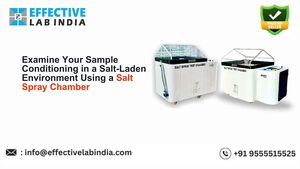Examine Your Sample Conditioning in a Salt-Laden Environment Using a Salt Spray Chamber
Corps
In the world of testing, it is important to ensure that the product can withstand harsh environmental conditions. One of the most difficult situations for many things is exposure to a salt-laden environment. Salt spray chambers provide a controlled method for testing materials durability under these conditions. Let’s go over how you can test your sample conditioning in the presence of a salt-laden environment using a salt spray chamber.
What is Sample Conditioning?
Sample conditioning refers to the preparation of samples for testing under specific environmental conditions. The objective is to simulate a high-temperature environment to investigate the long-term behaviour of materials in the salt spray chamber. This process helps designers, engineers, and scientists predict the longevity and performance of materials by subjecting them to certain conditions.
The Importance of Salt Spray Chambers in Sample Conditioning
Salt spray cabinets play an important role in the evaluation of corrosion resistance of materials. Companies ranging from automotive to manufacturing rely on these facilities to test metals, coatings and other materials. By simulating salty products, companies can predict how products will perform in coastal areas or when exposed to the outdoors for extended periods of time.
How Salt Spray Chambers Work
Salt spray test machines are designed to create a controlled corrosive environment. They produce a fine mist of saltwater, which mimics corrosion conditions, especially in offshore industrial areas. Here is a breakdown of the main components and techniques.
Salt Spray Chamber Components
- Spray Nozzles: Disperse the salt solution into a fine mist.
- Chamber Interior: The enclosed space where samples are exposed to the mist.
- Heaters: Maintain the temperature for accelerated corrosion testing.
- Solution Reservoir: Holds the saltwater solution used for testing.
Key Processes in a Salt Spray Test
- Sample Placement: Samples are placed inside the chamber, usually on racks, ensuring even exposure.
- Misting: The salt solution is sprayed in the chamber, simulating the corrosive environment.
- Monitoring: Sensors track temperature, humidity, and spray density for consistency.
Why is Sample Conditioning Necessary?
In many applications, products are subjected to environments that can cause corrosion, leading to corrosion, resulting in failure or shortened service life. By creating the prototypes, you can analyse how the materials will behave before using them in the real world.
Understanding the Salt-Laden Environment
A salt-laden environment refers to areas with high levels of salinity in the air or water. Coastal areas, industrial areas, where desalination is widely used are prime examples. These areas are hard on materials and things deteriorate quickly.
Characteristics of Salt-Laden Atmospheres
- High Salt Content: Salt in the air and water accelerates corrosion.
- Moisture: Humidity amplifies the corrosive effects of salt.
- Temperature Variations: Fluctuating temperatures can increase stress on materials.
Environmental Impacts on Samples
When exposed to salt-laden conditions, Different materials behave differently under different salinity conditions. The metal can rust, while the coating can be peeled or damaged.
Metal Corrosion in Salt Spray Conditions
Metals, especially iron and steel, are very susceptible to corrosion when exposed to salt. Over time, corrosion weakens the structural integrity, leading to failure.
Effects on Paints, Coatings, and Plastics
Salt spray can cause paint and coatings to blister, flake or peel. Although plastic is highly resistant, it can soften or discolour.
The Process of Sample Conditioning in Salt Spray Chambers
Proper sample conditioning provides consistent, reliable results. Here are instructions for preparing your samples for salt spray testing.
Preparing Samples for Testing
- Sample selection guidelines: Select materials that represent real-world applications. Clean samples thoroughly to remove contaminants that may affect test results.
- Setting Up the Test Environment: Ensure that the chamber is calibrated and that the temperature, humidity, and salt spray are installed as required by the test.
Monitoring During the Salt Spray Test
Throughout the test, constant monitoring is essential to ensure accuracy.
Factors Affecting Test Results
- Spray Density: Uneven misting can lead to inconsistent corrosion patterns.
- Temperature and Humidity: Variations can accelerate or slow corrosion.
Data Collection and Analysis
Data collected throughout the test helps to identify trends in degradation. Use this data to evaluate product performance over time.
Conclusion
Salt spray test chamber provides a reliable method for testing the durability of materials in salt-laden environments. By properly conditioning your samples and following best practices, you can ensure that your product is ready to withstand even harsh conditions. Understanding environmental influences, controlling test conditions, and maintaining equipment will ensure consistent and accurate results.
FAQs
FAQ 1: What are the limitations of salt spray testing?
The salt spray test is not entirely comparable to real environmental factors such as UV exposure or temperature variables.
FAQ 2: Can salt spray tests simulate real-world conditions accurately?
Although corrosive conditions are simulated, salt spray tests are accelerated and may not correspond exactly to real environments.
FAQ 3: How long does a typical salt spray test take?
Depending on materials and test data, testing can range from 24 hours to several weeks.
FAQ 4: What industries benefit most from salt spray chamber testing?
The automotive, marine, construction, and energy industries rely heavily on salt spray testing for corrosion resistance.
FAQ 5: How can I ensure my samples are tested properly?
Follow industry guidelines for sample preparation, experimental conditions, and data analysis to obtain accurate results.









commentaires